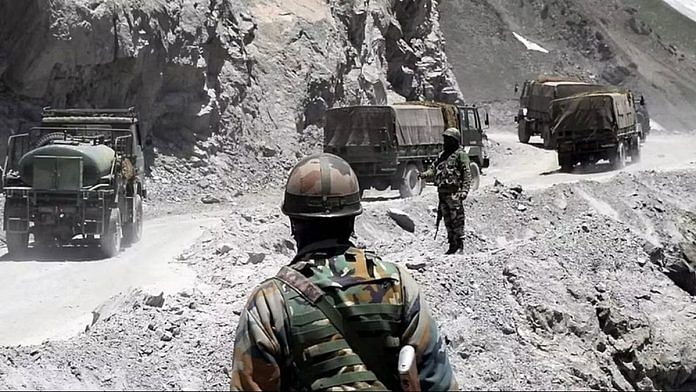India and China remain locked in a desperate attempt to look good to each other, so that their two leaders can meet in an amicable environment on the sidelines of the BRICS Summit in South Africa. The importance given to this meeting can be gauged by the fact that the military talks are now well into their second week, involving officers posted at the operational levels, from Corps Commander downwards. A seasoned analyst believes that the as yet unannounced meeting between Prime Minister Narendra Modi and President Xi Jinping occupies far greater priority than the entirety of the BRICS Summit.
This isn’t the first time India and China have suddenly initiated a military dialogue in the run up to an important diplomatic summit. The 18th round of Corps Commander level talks were even held on a Sunday to facilitate a conducive environment for the then upcoming Shanghai Cooperation Organisation meetings, including one scheduled between the Indian and Chinese defence ministers.
The current BRICS Summit in South Africa has been preceded by the 19th round of Corps Commander level talks, but in a very real sense these are now the most unusual of the talks held thus far.
Also read: Rajiv Gandhi cleaned up the wounds Indira left on Indian democracy. He deserves more credit
What’s different this time
For one, the Corps Commanders in fact met over two days rather than the usual single day meeting. And in a departure from past such meetings, the joint statement was issued on the same evening. Such alacrity is not something that has happened every time the two sides have sat down to thrash out the vexatious issue of Ladakh’s border areas. While the Corps Commanders met in the run up to India’s Independence Day, the two militaries are still continuing the talks. Since then, Major General level talks have been held, and they will now continue at battalion or brigade commander levels.
In addition, this duration of talks is clearly unprecedented, not just in the context of India-China talks but in the field manual of military talks in general. Two military sides, coming from opposing positions will initiate a dialogue to bring in a semblance of order into a dispute of significant national importance. A routine flag meeting would have been sufficient for any ordinary contentious issue. But such a sustained meeting almost only happens once there is a ceasefire after hostilities, punch for punch. So this weeks-long military-to-military dialogue clearly indicates something bigger is on the menu card.
Though the stage is being prepared to create a conducive environment for leadership talks in South Africa, the larger purpose could well be the upcoming G20 meetings in New Delhi under India’s presidency. The presence of headline-making foreign leaders in India could well be soured if the prickly Chinese President decides an alternative narrative. In any case, the two sides have widely disparate narratives on the ongoing dispute. Even as Prime Minister Modi denied there had been any intrusions, reports on ground clearly suggested otherwise. This is not something that will escape the attention of discerning international observers.
Also read: China wants to turn BRICS into an anti-G7 grouping. And push yuan instead of common currency
India’s missing reactions
The compulsion on Indian side is even more apparent when it comes to the diplomatic procedure of issuing démarches for all and sundry issues. Canada has frequently been on the receiving end over anti-India events in that country. But when it comes Chinese intrusions into Indian territory, the Ministry of External Affairs has yet not issued a single démarche!
There wasn’t one even after a score brave Indian soldiers made the ultimate sacrifice at Galwan. So it is too much to expect India admonishing China for sending a spy balloon over the Andaman Islands despite evidence that later suggested some serious real time snooping capabilities. Not that China would have been bothered much by this.
India can’t even call in the Chinese Ambassador for a dressing down since there isn’t one for almost a year now! This is also unprecedented, and is also taken as a measure of how much value Beijing places on relations with India, or doesn’t. This is an indicator that there is much that is unequal between India and China, not just in terms of power and profile but also in terms of how much the other values the relationship. India, said an astute observer, conducts itself in such a manner it doesn’t poke China in the eye!
In all this flurry, should there be an agreement centred around a pullback of positions, its long-term ramifications must be understood. The earlier announcement of a disengagement agreement was rightly critiqued for being heavily restrictive on India’s interests. Disengagement happened on unfavourable terms since the new positions to be adopted are deeper inside Indian territory and with severe restrictions on patrolling rights. Which is what India has, in any case, lost in the recent past. The candour in Ladakh Police chief’s note at the Director General level conference wasn’t just about loss of patrolling points as highlighted.
“Till September 2021, senior officers of district administration and security forces would easily patrol till Karakoram Pass, 35 kms from Daulet Beg Oldi)…but now check posts at DBO stop them…since PLA has installed cameras and they would immediately raise objections on the movement from Indian side”. She then also highlighted the fact that earlier grazers would take their livestock into rich pastures almost up to India’s patrolling points, but enhanced restrictions since 2014 has denied them access.
This is of course long before China altered the Line of Actual Control in 2020, also apparent to all international observers.
Manvendra Singh is a Congress leader, Editor-in-Chief of Defence & Security Alert and Chairman, Soldier Welfare Advisory Committee, Rajasthan. He tweets @ManvendraJasol. Views are personal.
(Edited by Anurag Chaubey)



